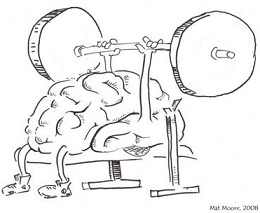Exercises for brain training

Because of my mental attitude or long-standing hobby for speed reading, mnemotechnics and other things, I had an increased interest in games consisting of a set of exercises for brain training (BrainChallenge, Dr. Kawashima, etc.). Having outplayed almost everything that was on the desktop and nds, there was a desire to use such games for everyday workouts, but for this they are not quite suitable (in the text I will explain why). Therefore, at leisure, I decided to write a small website with a set of such exercises.
Why do we need such training?
First, doing the exercises can be just fun. Observe what the brain is capable of, at what speed what complexity of the task it can solve. From a pragmatic point of view, things are a little more complicated. As far as I know, there are studies that show the benefits of such exercises for the development of cognitive abilities, and they say that there is no sense in them. I tend to the fact that once the brain is a part of the body, then the rule should be fulfilled that what is subjected to regular loads, should be developed to cope with them. If, however, I took my practice, I gave up classes several times, but as a result I always returned, as I began to feel that something was missing. I think you can draw a complete analogy with the training of the body, like you can without it, then you feel more comfortable with it.
Two types of thinking
A bit heavily simplified speculation. I would divide thinking into two types - mechanical and creative. What is mechanical thinking is when we have a visible state graph and therefore the speed and ability to solve a problem depends only on how quickly we can get around this graph. It helps us: as far as we can concentrate on the task, the speed and amount of memorization of intermediate results, the speed of recalling information from experience to discard parts of branches, the amount of attention, etc. As mentioned above, I believe that all these processes are quite amenable to training, and as a result, these trainings help to directly solve this kind of problem. On the other hand, there is also a creative component, when the graph is so large that it is physically impossible to go through all the options, and in fact it remains only to hope for insight. There are methods that partially solve the problem of creative thinking, such as brainstorming, morphological analysis, TRIZ. But I have doubts about any systematic process of training this type of thinking. From all this we can conclude that this kind of exercise will most likely make you more intelligent, but it is unlikely that they will make Einstein out of you.
')
A little bit about mnemonics.
Of all the exercises I would like to highlight the memorization of the list of words. Mnemotechnics for solving this problem have two main techniques, receiving places and receiving a plot. First - you need to choose a well-known place, such as an apartment or the way to work. And in iconic places to place images of words. Accordingly, to remember the list, it will be enough to walk mentally around the apartment and see what you have there, a significant emphasis is placed on visual memory. With the plot, everything is a little more interesting, you need to come up with a story consisting of words, and when you remember it, the words will also be remembered, the visual memory is also used here, but the meaning memory also appears. So, memorizing the list of words with the plot, I think, besides the mechanical component of the brain, allows you to touch on something creative as well, because it’s not always easy to come up with an image for the word and link it competently with others to the plot, and you have to significantly use attributed to the tools of creativity.
What is wrong with boxed games?
1) The main problem is that such games have practically no difficulty setting, which eventually leads to their uselessness. The obvious solution is that the exercises should be customizable whenever possible, so that a person can choose the complexity for themselves and gradually increase it.
2) The games do not have, as I believe, the most effective mode.
How this is implemented on the site. Each exercise has three difficulties.
Simple: mistakes are made.
Normally: in case of an error, the exercise will be re-read.
Difficult: Normal + every response has a time limit.
This is the third option I consider the most effective. Since it achieves maximum concentration and you begin to physically feel how the brain moves.
Total
ru.brainexer.com or www.brainexer.com
If I were interested, I would suggest that before starting the working day, spend time on exercises, and look at the result. Maybe in a week's time you will notice a slight cognitive enlightenment.
Source: https://habr.com/ru/post/155859/
All Articles